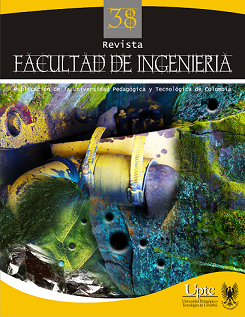Norte de Santander Alumino silicates Minerals' Evaluation for the Big Scale Ceramic Pieces Manufacturing

Abstract
This study shows the influence results of adding feldspar to clay materials from the metropolitan area of Cucuta (Colombia), in relation to key variables that are taken into account, when making a large format traditional ceramic product, through technical extrusion forming. The materials used were clays from the León and Guayabo formations, and the feldspar from the Sardinata town, all of which were studied by X-ray diffraction (XRD) and X-ray fluorescence (XRF). The specimens were formed in proportions of 100:0, 90:10 and 80:20 clay-feldspar, and were subjected to baking at temperatures of 950 °C-1000 °C-1050 °C. It was observed that the addition of feldspar, significantly improved the properties studied for all clays used in comparison with the standard mixture. The samples prepared with Támesis clay presented the best performance.Keywords
red ceramics, feldspar, warping, Támesis clay
References
- J. Sánchez, J. F. Gelves, Y. A. Romero, “Caracterización tecnológica y del talento humano de las empresas fabricantes de cerámica roja ubicadas en el área metropolitana de Cúcuta”, Revista Respuestas, año l7, N.° 2, pp. 71-80, 2012.
- D. Torres y J. Sánchez, Análisis del impacto socioeconómico del sector cerámico del Área Metropolitana de Cúcuta a raíz de la problemática actual de las relaciones bilaterales entre Colombia y Venezuela. Universidad Francisco de Paula Santander. Facultad de Ingeniería. Trabajo de grado Ingeniería de Producción Industrial. San José de Cúcuta, 2011.
- J. Sánchez, Estrategias para la competitividad del clúster de la cerámica del Área Metropolitana de Cúcuta. Universidad Nacional Experimental del Táchira. Trabajo de grado Maestría en Gerencia de Empresas, Mención Industria. San Cristóbal, Venezuela, 2010.
- P. Ramírez, Planteamiento estratégico para el desarrollo de la innovación tecnológica en el sector cerámico del área metropolitana de Cúcuta. Universidad Nacional Experimental del Táchira. Trabajo de grado Maestría en Gerencia de Empresas, Mención Industria, San Cristóbal, Venezuela, 2010.
- L. Pineda, Estrategia para la conformación del clúster y plan estratégico para la cadena de cerámica en Cúcuta. Segundo informe. Bogotá D.C, QubitCluster, 2007.
- J. Betancur y J. F. Gelves, Diagnóstico de los procesos de secado, cocción y manejo ambiental en las empresas productoras de tableta vidriada de la zona metropolitana de San José de Cúcuta. Universidad Francisco de Paula Santander. Facultad de Ingeniería. Trabajo de grado Ingeniería de producción industrial. San José de Cúcuta. 2006.
- J. Sayago y O. Toloza, Estudio de los defectos mayores en la tableta vitrificada de la Ladrillera Casablanca. Universidad Francisco de Paula Santander. Facultad de Ingeniería. Trabajo de grado Ingeniería de Producción Industrial. San José de Cúcuta, 2006.
- C. Sánchez, “La mullita y su identificación en materiales cerámicos”. Boletín de la Sociedad Española de Cerámica y Vidrio, vol. 5, No. 1, pp. 79-106,1996.
- J. Anggono, “Mullite Ceramics: Its Properties, Structure, and Synthesis”, Jurnal Teknik Mesin, vol. 7, N° 1, pp. 1-10, 2005.
- A. I. Avgustinik. Cerâmica. Versión española por Diorki, traductores S.A. Barcelona: Reverté, segunda edición, pp. 125-126, 1983.
- P. Díaz del Río P., S. Consuegra y R. Domínguez, “Identificación de una tradición tecnológica cerámica con desgrasante óseo en el neolítico peninsular. Estudio arqueométrico de materiales cerámicos de Madrid (5300-3400 cal AC)”, Trabajos de prehistoria, 68, No. 1, pp. 99-122, 2011.
Downloads
Download data is not yet available.